The Salvadore Dali Theatre-Museum, Figueres, Catalonia

Salvadore Dali was born in Figueres, Catalonia in 1904. Although his childhood home was in Figueres, he spent much of his childhood at his family’s nearby summer home in the small coastal village of Cadaques on the Costa Brava. Today, the Dali Theatre-Museum in Figueres houses a collection of works from this eccentric icon. Our guests will enter the wacky world of Salvadore Dali in Figueres and Cadaques.
Dali lived from 1904-1989. During his lifetime, he became a hero of the Surrealist art movement and remains so today. His passions were painting, drawing, sculpture, writing and film. His once said he attributed his ‘love of everything that is gilded and excessive, his passion for luxury and his love of oriental clothes’ to his Arab lineage. He claimed his ancestors were descended from the Moors who invaded Spain in AD 711. Dali was highly imaginative and enjoyed indulging in eccentric and grandiose behavior throughout his lifetime.
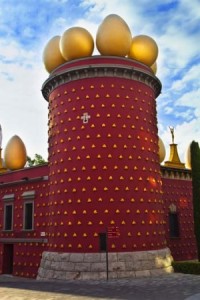 In the 1920‘s, he went to Paris to interact and collaborate with artists such as Picasso, Miro, Matisse and others whose influence can be seen in his work. Few artists have had a greater impact on 20th century art than Salvador Dali. Among Surrealism’s most important contributions was his invention of new artistic techniques that tapped into the unconscious mind.
In the 1920‘s, he went to Paris to interact and collaborate with artists such as Picasso, Miro, Matisse and others whose influence can be seen in his work. Few artists have had a greater impact on 20th century art than Salvador Dali. Among Surrealism’s most important contributions was his invention of new artistic techniques that tapped into the unconscious mind.
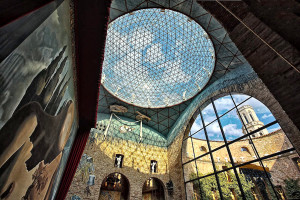 Not only is the Dali Theatre-Museum building a work of art in its own right, it contains the largest and most diverse collection of works by Salvador Dali, many of which are from the artist’s own collection. He painted the exterior of the building crimson and stuck loaves of bread to the walls (made from plaster). The roof is lined with large eggs and gilded sculptures. Dali lived in the tower of the Theatre-Museum, where he died in 1989. He was laid to rest in the crypt under the museum’s geodesic dome.
Not only is the Dali Theatre-Museum building a work of art in its own right, it contains the largest and most diverse collection of works by Salvador Dali, many of which are from the artist’s own collection. He painted the exterior of the building crimson and stuck loaves of bread to the walls (made from plaster). The roof is lined with large eggs and gilded sculptures. Dali lived in the tower of the Theatre-Museum, where he died in 1989. He was laid to rest in the crypt under the museum’s geodesic dome.
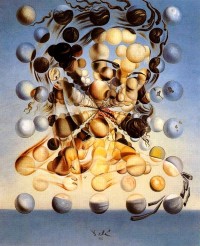
We’ll experience some of his well-known paintings, sculptures, collages, jewelry and ‘accessorized’ rooms. Can we get a glimpse into Dali’s ‘genius’? Maybe…
“I don’t do drugs. I am drugs. Take me – I am hallucinogenic.
~ Salvadore Dali
The Guggenheim Museum, Bilbao, Basque Country
The Guggenheim Museum is a modern art museum designed by Canadian-American architect Frank Gehry. The museum, built along the Nervion River that runs through the city of Bilbo to the Cantabrian Sea, is one of several museums belonging to the Solomon R. Guggenheim Foundation. It features permanent and visiting exhibits of works by Spanish and international artists.
 The building itself is one of the most admired works of contemporary 20th century architecture. It represents “a rare moment when critics, academics and the general public are completely united”. The building has been hailed as one of the most spectacular buildings in the world. Made of titanium, limestone and glass, Gehry designed a spectacular sculpture-like structure integrated with Bilbao’s urban pattern and surrounding areas. The result is a visual impact that has now become an icon of Bilbao throughout the world.
The building itself is one of the most admired works of contemporary 20th century architecture. It represents “a rare moment when critics, academics and the general public are completely united”. The building has been hailed as one of the most spectacular buildings in the world. Made of titanium, limestone and glass, Gehry designed a spectacular sculpture-like structure integrated with Bilbao’s urban pattern and surrounding areas. The result is a visual impact that has now become an icon of Bilbao throughout the world.
Once inside the hall, visitors access the Atrium, the heart of the museum. With curved designs and large glass walls, the Atrium is a space flooded with light from the glass ‘curtains’ and covered with a great skylight. Three levels of the building are organized around the Atrium and are connected by curved walkways, glass elevators and staircases. The Atrium, a gallery in itself, also serves as an axis for 20 additional art galleries.
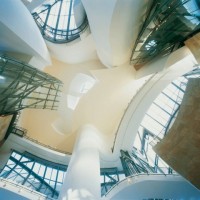
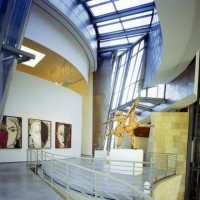 This museum is a must-see when in the Basque country. Our guests will have a guided tour of the museum which will include the architecture of the building as well as an introduction to the works on display. We will stay in Bilbao in very close proximity to the museum where views of the museum can be seen from the hotel. Join us on our Spain tour and experience both of these exceptional art museums!
This museum is a must-see when in the Basque country. Our guests will have a guided tour of the museum which will include the architecture of the building as well as an introduction to the works on display. We will stay in Bilbao in very close proximity to the museum where views of the museum can be seen from the hotel. Join us on our Spain tour and experience both of these exceptional art museums!
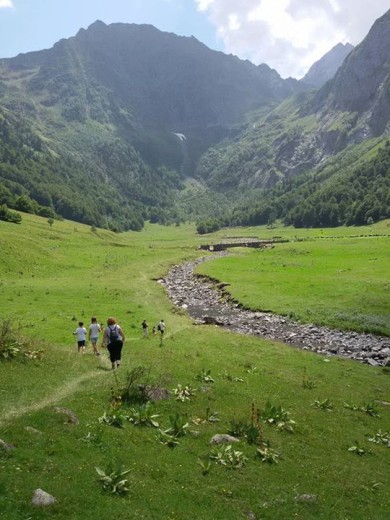
 Large mammal habitat in the area include wild horses, goats, deer and boar. A variety of birds live in the heights of the granite mountain cliffs, clinging to sheer faces and nesting in cracks or cornices. Brown trout swim in lakes and rivers. Grassy glacial valley floors are ripe for exploring as well as the many hiking trails in the park. This is a place to take in nature at its finest and the peace it brings.
Large mammal habitat in the area include wild horses, goats, deer and boar. A variety of birds live in the heights of the granite mountain cliffs, clinging to sheer faces and nesting in cracks or cornices. Brown trout swim in lakes and rivers. Grassy glacial valley floors are ripe for exploring as well as the many hiking trails in the park. This is a place to take in nature at its finest and the peace it brings. Visitors can only get into the park by 4-wheel Land Rover taxi. We will have local drivers/guides who will drive us to scenic points. For those who want to hike, there will be option to take an easy group hike along the way or back to town on our return. During the day, we’ll enjoy a picnic lunch prepared by our own tour guides. It will be a day filled with magnificent scenery and unforgettable moments!
Visitors can only get into the park by 4-wheel Land Rover taxi. We will have local drivers/guides who will drive us to scenic points. For those who want to hike, there will be option to take an easy group hike along the way or back to town on our return. During the day, we’ll enjoy a picnic lunch prepared by our own tour guides. It will be a day filled with magnificent scenery and unforgettable moments! 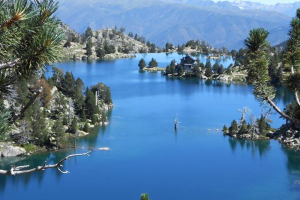

 Tapas originated in Spain, where according to legend, King Alfonso X had been stricken with a serious illness which only allowed him to take in small portions of food with small amounts of wine. After recovering from his illness, the good king issued a decree that no wine should be served at inns unless it was served with food. Whatever the reason, today, tapas are the perfect way to experience the flavors and rich culture of Spain.
Tapas originated in Spain, where according to legend, King Alfonso X had been stricken with a serious illness which only allowed him to take in small portions of food with small amounts of wine. After recovering from his illness, the good king issued a decree that no wine should be served at inns unless it was served with food. Whatever the reason, today, tapas are the perfect way to experience the flavors and rich culture of Spain. On our ‘tapas crawl’ we will search out the best tapas bars in Barcelona. You will be able to hear snippets of conversations by the locals. Don’t be surprised if you are approached by patrons wanting to practice their English. Be assured, you will taste the best tapas and experience this traditional Spanish custom. Close your eyes and pretend you are a local for a night!
On our ‘tapas crawl’ we will search out the best tapas bars in Barcelona. You will be able to hear snippets of conversations by the locals. Don’t be surprised if you are approached by patrons wanting to practice their English. Be assured, you will taste the best tapas and experience this traditional Spanish custom. Close your eyes and pretend you are a local for a night! They say, “Pintxos = life at its finest”. Pintxos are tapas prepared the Basque way and are an expression of ‘miniature cuisine’. The Basques call their tapas pintxos, (pronounced peench-os) from the Spanish word pinchar, meaning ‘to prick’. In San Sebastian, the same cultural and culinary tradition is called a ‘pintxos hunt’. On our pintxo hunt, we will see pintxos with banderillas, or long toothpicks, which get their name from the darts in a bullfight. Banderillas are helpful in holding together and picking up pintxos. Pintxos are small portions of food, generally taken from a bigger part or bread topped with an array of ingredients. A ‘pintxos hunt’ is an exciting culinary experience for foodies.
They say, “Pintxos = life at its finest”. Pintxos are tapas prepared the Basque way and are an expression of ‘miniature cuisine’. The Basques call their tapas pintxos, (pronounced peench-os) from the Spanish word pinchar, meaning ‘to prick’. In San Sebastian, the same cultural and culinary tradition is called a ‘pintxos hunt’. On our pintxo hunt, we will see pintxos with banderillas, or long toothpicks, which get their name from the darts in a bullfight. Banderillas are helpful in holding together and picking up pintxos. Pintxos are small portions of food, generally taken from a bigger part or bread topped with an array of ingredients. A ‘pintxos hunt’ is an exciting culinary experience for foodies.
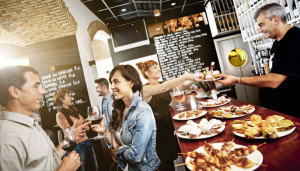 Eat, drink, observe, listen and learn!
Eat, drink, observe, listen and learn! Basque pintxos are usually:
Basque pintxos are usually: